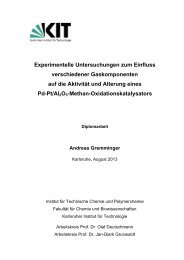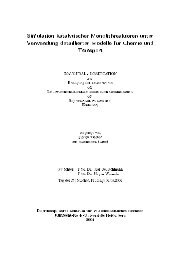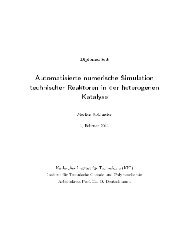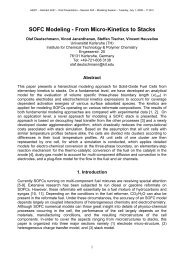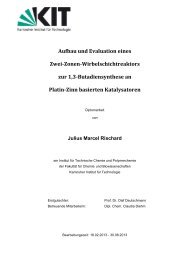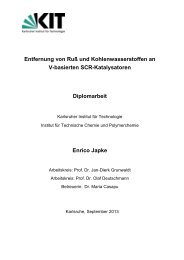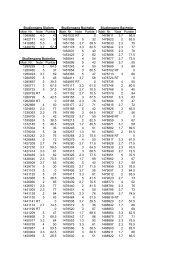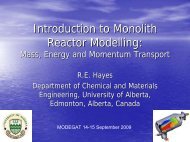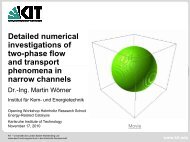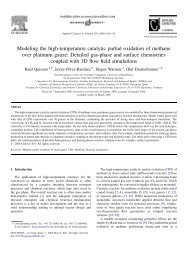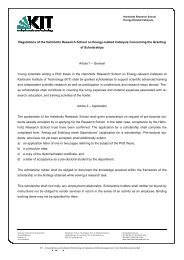Fuel Processing for Fuel Cells - Institut für Technische Chemie und ...
Fuel Processing for Fuel Cells - Institut für Technische Chemie und ...
Fuel Processing for Fuel Cells - Institut für Technische Chemie und ...
Create successful ePaper yourself
Turn your PDF publications into a flip-book with our unique Google optimized e-Paper software.
Author's personal copy<br />
56 Torsten Kaltschmitt and Olaf Deutschmann<br />
Insulation<br />
Catalyt.<br />
monolith<br />
Ar, CH 4<br />
, O 2<br />
Insulation 1 s 2 s 5 s 7 s 10 s<br />
T<br />
CH 4<br />
12 s<br />
0.1 s<br />
15 s 17 s 20 s 60 s 120 s<br />
10 s 100 s<br />
O 2<br />
H 2<br />
H 2<br />
O<br />
CO<br />
CO 2<br />
Figure 19 Numerical simulation of the light-off of a Rh/Al 2 O 3 -coated monolithic<br />
honeycomb reactor <strong>for</strong> partial oxidation of methane to synthesis gas (Schwiedernoch<br />
et al., 2003). Top panel: temperature of the solid structure of the catalytic monolith and<br />
the thermal insulation (675 K (blue) to 925 K (red)). Lower panel: gas-phase temperature<br />
(385–900 K) and species mole fractions (CH 4 : 0.043–0.094, O 2 : 0–0.055, H 2 : 0–0.0412,<br />
H 2 O: 0–0.058, CO: 0–0.042, CO 2 : 0–0.056) in a single channel in the center of the<br />
monolith, red¼maximum, blue¼minimum. The time is set to zero when significant<br />
amounts of products can be observed after the reactor was heated up to the ignition<br />
temperature of 675 K.<br />
be operated with. Eventually, the fuel cell type and its operating temperature<br />
eventually determine the chemical composition of the fuel <strong>for</strong> the<br />
fuel cell. In most cases, hydrogen or hydrogen-rich gases are used as fuel.<br />
The amount of other components aside from the hydrogen the cell can<br />
take without damage or loss in per<strong>for</strong>mance can vary from few ppm in the<br />
case of low-temperature PEMFCs to 100% in the case of high-temperature<br />
SOFCs. The maximum amount of by-products specified by the fuel cell<br />
type <strong>und</strong>er consideration basically determines the amount of final cleaning<br />
of the fuel such as removal of CO and hydrocarbons. The original<br />
chemical feedstock is usually not directly used in a fuel processor<br />
designed <strong>for</strong> the specific fuel cell application, rather logistically available



